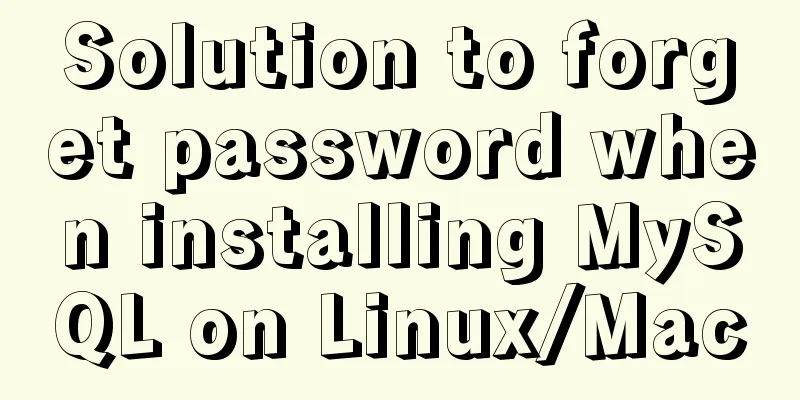Detailed explanation of binary and varbinary data types in MySQL

|
Preface BINARY and VARBINARY are somewhat similar to CHAR and VARCHAR types, except that BINARY and VARBINARY store binary strings rather than character strings. In other words, BINARY and VARBINARY do not have the concept of character sets, and their sorting and comparison are all based on binary values. The N in Let’s look at the following example. mysql> CREATE TABLE t ( -> a BINARY(1) ->)ENGINE=InnoDB CHARSET=GBK; Query OK, 0 rows affected (0.02 sec) mysql> SET NAMES GBK; Query OK, 0 rows affected (0.00 sec) MySQL> INSERT INTO t SELECT 'i'; Query OK, 1 row affected, 1 warning (0.01 sec) Records: 1 Duplicates: 0 Warnings: 1 mysql> SHOW WARNINGS\G; *************************** 1. row *************************** Level: Warning Code: 1265 Message: Data truncated for column 'a' at row 1 1 row in set (0.00 sec) mysql> SELECT a,HEX(a) FROM t\G; *************************** 1. row *************************** a: HEX(a): CE Table t contains a column of type mysql> CREATE TABLE t ( -> a CHAR(1) ->)ENGINE=InnoDB CHARSET=GBK; Query OK, 0 rows affected (0.02 sec) mysql> INSERT INTO t SELECT 'I'; Query OK, 1 row affected, 1 warning (0.01 sec) Records: 1 Duplicates: 0 Warnings: 0 mysql> SELECT a,HEX(a) FROM t\G; *************************** 1. row *************************** a: I HEX (a): CED2 1 row in set (0.00 sec) The first difference between BINARY and VARBINARY compared to CHAR and VARCHAR is that the N value in
mysql> SELECT
-> HEX('a'),
-> HEX('a '),
-> 'a'='a '\G;
*************************** 1. row ***************************
HEX('a'): 61
HEX('a '): 612020
'a'='a': 1
1 row in set (0.00 sec)
mysql> SELECT
-> HEX(BINARY('a')),
-> HEX(BINARY('a ')),
-> BINARY('a') = BINARY('a ')\G;
*************************** 1. row ***************************
HEX(BINARY('a')): 61
HEX(BINARY('a ')): 612020
BINARY('a') = BINARY('a '): 0
1 row in set (0.00 sec)For CHAR and VARCHAR, character values are compared, so the return value of the first comparison is 1. For BINARY and VARBINARY, the comparison is on binary values. The hexadecimal value of "a" is 61, and the hexadecimal value of "a " is 612020, which are obviously different. Therefore, the return value of the second comparison is 0. The third difference is that for BINARY strings, the fill character is 0x00, while the fill character for CHAR is 0x20. This may be because of the BINARY comparison requirement. 0x00 is obviously the minimum character for comparison. The example is as follows: mysql> CREATE TABLE t ( a BINARY(3)); Query OK, 0 rows affected (0.00 sec) mysql> INSERT INTO t SELECT 'a'; Query OK, 1 row affected (0.00 sec) Records: 1 Duplicates: 0 Warnings: 0 mysql> SELECT a,HEX(a) FROM t\G; *************************** 1. row *************************** a: a HEX(a): 610000 1 row in set (0.00 sec) Summarize The above is the full content of this article. I hope that the content of this article can bring some help to your study or work. If you have any questions, you can leave a message to communicate. Thank you for your support of 123WORDPRESS.COM. You may also be interested in:
|
<<: Detailed explanation of the use of React.cloneElement
>>: React sample code to implement login form
Recommend
Vue realizes the function of uploading photos on PC
This article example shares the specific code of ...
Detailed steps to install MySql 5.7.21 in Linux
Preface The most widely used database in Linux is...
MySQL Index Optimization Explained
In daily work, we sometimes run slow queries to r...
Detailed explanation of Tomcat directory structure
Table of contents Directory Structure bin directo...
Example code for implementing div concave corner style with css
In normal development, we usually use convex roun...
Analysis of the implementation process of Docker intranet penetration frp deployment
1. Create a configuration file directory cd /home...
Detailed explanation of the process of building Prometheus+Grafana based on docker
1. Introduction to Prometheus Prometheus is an op...
Ubuntu Basic Tutorial: apt-get Command
Preface The apt-get command is a package manageme...
How to use Flex layout to achieve scrolling of fixed content area in the head
The fixed layout of the page header was previousl...
19 MySQL optimization methods in database management
After MySQL database optimization, not only can t...
Detailed explanation of basic syntax and data types of JavaScript
Table of contents Importing JavaScript 1. Interna...
In-depth understanding of Mysql logical architecture
MySQL is now the database used by most companies ...
H tags should be used reasonably in web page production
HTML tags have special tags to handle the title of...
Share 12 commonly used Loaders in Webpack (Summary)
Table of contents Preface style-loader css-loader...
Example method of deploying react project on nginx
Test project: react-demo Clone your react-demo pr...









